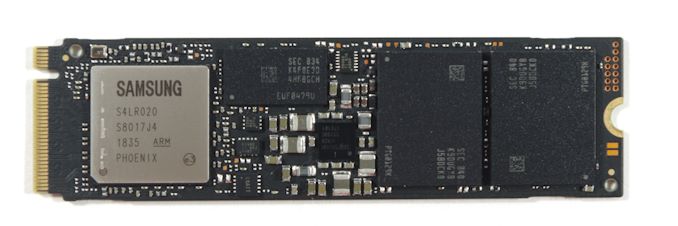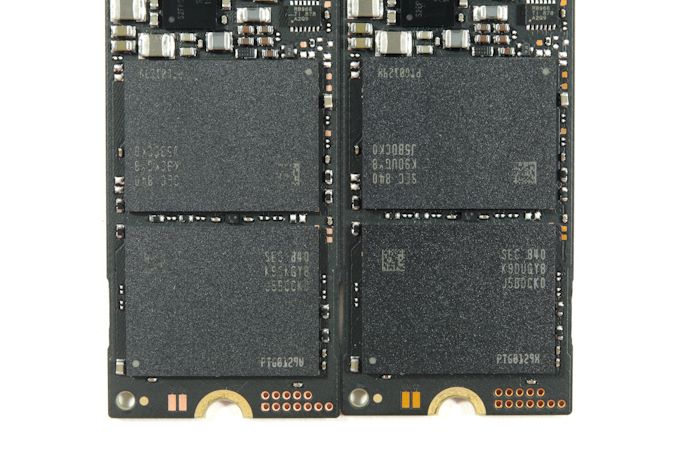The Samsung 970 EVO Plus (250GB, 1TB) NVMe SSD Review: 92-Layer 3D NAND
by Billy Tallis on January 22, 2019 10:00 AM ESTConclusion
The only technical change the Samsung 970 EVO Plus brings relative to last year's original 970 EVO is an upgrade from 64-layer 3D NAND to 92-layer 3D NAND. Fortunately, this change brings quite a few positive effects for end-users.
Samsung isn't the first to ship 9x-layer 3D NAND but they are the first to make it readily accessible to consumers in retail SSDs. This is Samsung's fifth generation 3D NAND and they have continued to improve not just the density and cost per GB, but also performance and power consumption. Those latter effects are more immediate, since the 970 EVO Plus is launching at similar prices to the 970 EVO it replaces. We do expect the 970 EVO Plus to continue the downward price trend that made 2018 such a great year for SSD buyers, but in the meantime the performance and power improvements are more interesting.
The 970 EVO Plus uses the same controller as the last generation of products, but it doesn't seem to get in the way of taking advantage of the new NAND's capabilities. With the 970 EVO Plus, Samsung retakes or strengthens their lead in some of our most challenging benchmarks. This is most noticeable in the tests that fill up the drive's SLC write cache, because the 970 EVO Plus has the best post-cache write speed we've measured from a TLC drive. This higher post-cache write speed is especially important given that Samsung's SLC caches are somewhat conservatively sized, at least in comparison to drives like the ADATA SX8200 that allow their SLC caches to grow to use almost the entire drive's array of flash memory.
The contrast between the SX8200's maximum size SLC cache strategy and the more reserved 970 EVO Plus cache sizes tends to allow the ADATA drive to perform better in ideal conditions, but hurts performance severely when the cache runs out. For the smallest drives in the 240GB–250GB range, ADATA's approach is probably a bit too aggressive because 240GB drives are fairly easy to fill up these days. A somewhat less aggressive SLC cache more like Samsung's mitigates the worst-case performance for the models that are most likely to actually hit that worst-case scenario in the real world.
Since the 970 EVO Plus does not introduce a new SSD controller, it still reflects Samsung's prioritization of performance over power efficiency. Western Digital and Toshiba have been demonstrating repeatedly that NVMe drives don't have to be power-hungry to hit the highest levels of performance, and Samsung is definitely lagging here in the overall picture. The 970 EVO Plus does score some efficiency wins, but only where it builds on the original 970 EVO's greatest strengths. For notebook use, the WD Black SN750's occasionally lower performance is absolutely worth the huge power savings.
| 240-280GB | 480-512GB | 960GB-1TB | 2TB | |
| Samsung 970 EVO Plus (MSRP) | $89.99 (36¢/GB) | $129.99 (26¢/GB) |
$249.99 (25¢/GB) |
|
| Samsung 970 EVO | $85.00 (34¢/GB) | $129.99 (26¢/GB) | $247.99 (25¢/GB) | $499.99 (25¢/GB) |
| Samsung 970 PRO | $167.99 (33¢/GB) | $399.99 (39¢/GB) | ||
| Western Digital WD Black SN750 (MSRP) | $79.99 (32¢/GB) | $129.99 (26¢/GB) | $249.99 (25¢/GB) | $499.99 (25¢/GB) |
| Western Digital WD Black (2018) | $84.99 (34¢/GB) | $119.98 (24¢/GB) | $234.99 (23¢/GB) | |
| ADATA XPG SX8200 Pro | $74.99 (29¢/GB) | $114.95 (22¢/GB) | $199.95 (20¢/GB) | |
| HP EX920 | $57.99 (23¢/GB) | $89.99 (18¢/GB) | $174.99 (17¢/GB) | |
| HP EX950 | $119.99 (23¢/GB) | $229.99 (22¢/GB) | $399.99 (20¢/GB) | |
| Mushkin Pilot | $59.99 (24¢/GB) | $99.99 (20¢/GB) | $189.99 (19¢/GB) | $399.99 (20¢/GB) |
| MyDigitalSSD BPX Pro | $54.99 (23¢/GB) | $99.99 (21¢/GB) | $189.99 (20¢/GB) | $519.99 (27¢/GB) |
| Corsair Force MP510 | $74.99 (31¢/GB) | $113.99 (24¢/GB) | $266.05 (28¢/GB) | $475.99 (25¢/GB) |
With Samsung launching the 970 EVO Plus at the same prices as the 970 EVO, they're taking one of the fastest TLC drives and making it a slightly better deal.
There aren't a lot of options for stepping up in performance from the 970 EVO Plus. The 970 PRO hasn't been updated to 96L NAND and has limited capacity options, and the Intel Optane SSD 900P is even more expensive. Both drives suffer from difficulty providing any tangible benefit over fast TLC drives for lighter workloads, and on heavier workloads the PCIe 3.0 x4 bottleneck becomes an issue. They also don't consistently beat the top TLC drives on synthetic benchmarks. Given what today's best TLC drives can do, MLC NAND and 3D XPoint memory both need to be regarded as niche options that cannot automatically be assumed to offer better real-world performance.
For most purposes, the 970 EVO Plus can now be regarded as Samsung's flagship consumer SSD, and it deserves that title. Its primary competition comes from NVMe drives that are much cheaper but offer similar real-world performance with lower worst-case synthetic benchmark performance.












35 Comments
View All Comments
kgardas - Friday, January 25, 2019 - link
Thanks for explanation! Actually makes sense indeed. This would also mean that if your workflow is read dominated and you are sensitive on latency than RAID1 of SATA drives may be faster than NVMe. At least if SATA/SAS chip is not a crap.ikjadoon - Tuesday, January 22, 2019 - link
Even a SATA SSD could pump 4 kB random read numbers up, but it'd require pricey SLC. MLC and TLC both have 2x to 4x slower page reads to register vs SLC.latency source: https://www.anandtech.com/show/6337/samsung-ssd-84...
Still, TLC 4 kB random has improved, but not by "leaps and bounds" like 4K write has. The 970 EVO Plus has 53% faster random 4kB reads (sustained) than the MX 500. And even a 960 PRO has 76% faster 4kB reads (sustained) than the MX500.
FWIW, random 4K read performance (both burst and sustained) doesn't benefit much of anything from parallelization. https://www.anandtech.com/bench/product/2229?vs=21... The 250 GB and 1 TB 960 EVO have identical 4K read performance, i.e. within 0.75%. Random 4K write and larger page sizes are about 2x faster on the 1 TB model, however.
Can't vouch for accuracy, but this answer sounds right: https://superuser.com/questions/1168014/nvme-ssd-w...
Alistair - Tuesday, January 22, 2019 - link
The performance is amazing, and I've been buying the 1TB SX8200 for $180 USD before tax. Nothing beats that still.Dark_wizzie - Tuesday, January 22, 2019 - link
1tb ex820 for $160 after tax and shipping beats it.palindrome - Tuesday, January 22, 2019 - link
You mean EX920 and it has been as low as $153 recently (before tax).gglaw - Tuesday, January 22, 2019 - link
Not too long ago it was $135 twice with the Ebay and Rakuten 15% coupons. $155 range seems almost every other week now and frequent enough I'd even consider it the typical selling price. (Very few people who follow tech would actually pay $180 for it). Can't beat this for consumer use with the small performance differences with current gen drives. When the EX950 and SX8200 Pro phase it out and drop to the same price points, they'll replace it as best consumer deals so I don't see the new Samsung or WD having a place in my line-up.If for some purpose I can find a use for something more expensive, it'd have to be the next gen 970 Pro (Plus?) if it's a major upgrade.
** A - R ** - Wednesday, January 23, 2019 - link
https://news.samsung.com/global/samsung-electronic...Billy, Specs in the official site mentions MLC, here I see it's TLC ! ?
Could You please verify it.
olafgarten - Wednesday, January 23, 2019 - link
It says 3 bit MLC, meaning TLC.mortenge - Wednesday, January 23, 2019 - link
Why do you bring Optain into the mix and not the 970 PRO, when all we care about is EVO vs PRO?alfatekpt - Wednesday, January 23, 2019 - link
The review should include 970 EVO 250GB numbers for comparison.